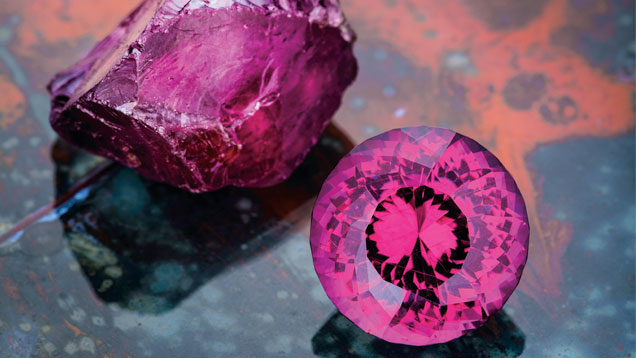Gems & Gemology Gives Colorful Insight into Garnet, Sapphire and Opal

Winter 2015 issue of GIA’s quarterly professional journal now available
CARLSBAD, Calif. – Feb. 1, 2016 – The Winter 2015 issue of GIA’s peer-reviewed journal Gems & Gemology (G&G) profiles a rich, bold pink Tanzanian garnet that shows a noticeable color change under different lighting conditions and exemplifies some of the finest garnet material. The issue also offers insight into the original source rocks of Montana’s alluvial sapphires, a gemological study of the historic Grand Sapphire once owned by Louis XIV, an investigation into tarnish spots on high-purity gold, and a field report on Australian opal. The issue is now available in print, and online with exclusive video content.G&G’s cover story, “Vanadium- and Chromium-Bearing Pink Pyrope Garnet: Characterization and Quantitative Colorimetric Analysis” by GIA research scientists Ziyin “Nick” Sun, Dr. Aaron Palke and Nathan Renfro, examines remarkable “color-change” pyrope garnet believed to be from Tanzania. Under fluorescent-equivalent lighting, larger gems have the color of fine purple amethyst, while under incandescent light they resemble hot pink tourmaline. The authors provide a comprehensive review of this material’s inclusions along with a quantitative analysis of its color under different lighting conditions.
Alluvial sapphires from the U.S. state of Montana have long been celebrated for their kaleidoscope of colors, but so far no one has located these gems’ primary source rocks. In the issue’s next article, “Alluvial Sapphires from Montana: Inclusions, Geochemistry, and Indications of a Metasomatic Origin,” a team of researchers led by Dr. J.C. “Hanco” Zwaan focus on mineral inclusions and geochemistry to propose a metasomatic origin of these gems.
In another feature, Dr. François Farges and his colleagues profile the fascinating history and gemology of Louis XIV’s 135.74 ct. Grand Sapphire, which was added to the French crown jewels in 1669. Through microscopic examination and spectroscopy, the authors determine this sapphire likely originated in Sri Lanka’s gem fields. In the fourth and final paper, Dr. Taijin Lu and his team from the National Gems & Jewellery Technology Administrative Center in Beijing investigate unsightly tarnish spots in high-purity gold jewelry using a combination of advanced techniques to detect the presence of silver and sulfur.
The issue also includes a field report by GIA’s Dr. Tao Hsu, Andrew Lucas and Vincent Pardieu on the mining activity and growing importance of “opal tourism” in four localities in Australia’s arid Great Artesian Basin: Lightning Ridge, Koroit, Yowah and Quilpie. In the Gem News International section, Pardieu provides an update on rubies from a new deposit in Zahamena National Park, Madagascar. There are also reports from the 2015 Geological Society of America annual meeting in Baltimore; the first International Emerald Symposium in Bogotá, Colombia; and the 34th International Gemological Conference in Vilnius, Lithuania.
Additional details about G&G, full articles, more in-depth coverage, hundreds of additional photos, and exclusive video footage are available on GIA’s website at http://www.gia.edu/gia-news-research.



